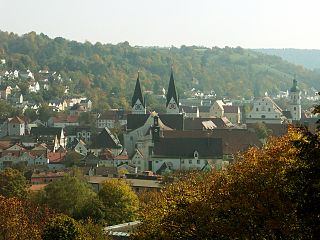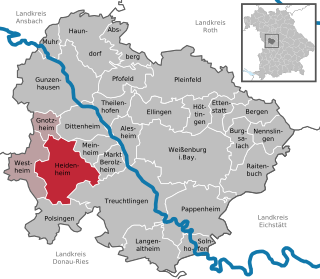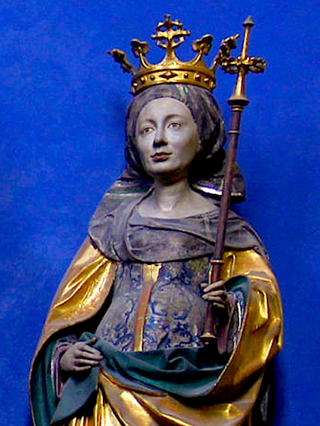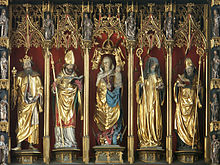
Boniface, OSB was an English Benedictine monk and leading figure in the Anglo-Saxon mission to the Germanic parts of Francia during the eighth century. He organised significant foundations of the church in Germany and was made bishop of Mainz by Pope Gregory III. He was martyred in Frisia in 754, along with 52 others, and his remains were returned to Fulda, where they rest in a sarcophagus which remains a site of Christian pilgrimage.

700 (DCC) was a leap year starting on Thursday of the Julian calendar, the 700th year of the Common Era (CE) and Anno Domini (AD) designations, the 700th year of the 1st millennium, the 100th and last year of the 7th century, and the 1st year of the 700s decade. As of the start of 700, the Gregorian calendar was 3 days ahead of the Julian calendar, which was the dominant calendar of the time.

Walpurgis Night, an abbreviation of Saint Walpurgis Night, also known as Saint Walpurga's Eve, is the eve of the Christian feast day of Saint Walpurga, an 8th-century abbess in Francia, and is celebrated on the night of 30 April and the day of 1 May. This feast commemorates the canonization of Saint Walpurga and the movement of her relics to Eichstätt, both of which occurred on 1 May 870.

Eichstätt is a town in the federal state of Bavaria, Germany, and capital of the district of Eichstätt. It is located on the Altmühl river and has a population of around 13,000. Eichstätt is also the seat of the Roman Catholic Diocese of Eichstätt.

The Via Francigena is an ancient road and pilgrimage route running from the cathedral city of Canterbury in England, through France and Switzerland, to Rome and then to Apulia, Italy, where there were ports of embarkation for the Holy Land. It was known in Italy as the "Via Francigena" or the "Via Romea Francigena". In medieval times it was an important road and pilgrimage route for those wishing to visit the Holy See and the tombs of the apostles Peter and Paul.

Walpurga or Walburga, also spelled Valderburg or Guibor, was an Anglo-Saxon missionary to the Frankish Empire. She was canonized on 1 May c. 870 by Pope Adrian II. Saint Walpurgis Night is the name for the eve of her feast day in the Medieval period, which coincided with May Day; her feast is no longer celebrated on that day, but the name is still used for May Eve.

July 6 - Eastern Orthodox Church calendar - July 8

The Basilica of San Frediano is a Romanesque church in Lucca, Italy, situated on the Piazza San Frediano.

Anglo-Saxon missionaries were instrumental in the spread of Christianity in the Frankish Empire during the 8th century, continuing the work of Hiberno-Scottish missionaries which had been spreading Celtic Christianity across the Frankish Empire as well as in Scotland and Anglo-Saxon England itself during the 6th century. Both Ecgberht of Ripon and Ecgbert of York were instrumental in the Anglo-Saxon mission. The first organized the early missionary efforts of Wihtberht, Willibrord, and others; while many of the later missioners made their early studies at York.

February 6 - Eastern Orthodox liturgical calendar – February 8

Willibald was an 8th-century bishop of Eichstätt in Bavaria.

Hygeburg, also Hugeburc, Hugeberc, Huneberc or Huneburc, was an Anglo-Saxon nun and hagiographer at the Alemannian monastery of Heidenheim. She is "the first known Englishwoman to have written a full-length literary work" and "the only woman author of a saint's life from the Carolingian period".

Saint Mildrith, also Mildthryth, Mildryth and Mildred,, was a 7th- and 8th-century Anglo-Saxon abbess of the Abbey at Minster-in-Thanet, Kent. She was declared a saint after her death, and, in 1030, her remains were moved to Canterbury.
Saint Edburga of Minster-in-Thanet was a princess of Wessex, and abbess of Minster-in-Thanet. She is regarded as a saint.

Heidenheim is a municipality in the Weißenburg-Gunzenhausen district, in Bavaria, Germany.

Winibald was abbot of the Benedictine double monastery of Heidenheim am Hahnenkamm. Traditionally, he is called the brother of Willibald and Walpurga.

Fridianus, was an Irish prince and hermit, fl. 6th century. Tradition names him as a son of King Ultach of Ulster. He later migrated to Italy, where he was appointed as Bishop of Lucca. The Basilica of San Frediano in the city is dedicated to him, as are churches in Florence.
Saint Thecla of Kitzingen was a Benedictine nun and abbess. Born in England, she went to Germany to assist Saint Boniface in his missionary labors.
Pellegrino of Ireland, Irish prince and hermit, fl. 7th-9th centuries. Returning from a pilgrimage to the Holy Land, he became a hermit in the mountain forests of Tuscany. His feast day is August 1.

Wuna of Wessex was a 7th and 8th-century Anglo-Saxon noblewoman and Christian saint. The name Wuna means "The Joyful One". Her actual name is unknown, but she has been called Wuna since the Middle Ages.

















